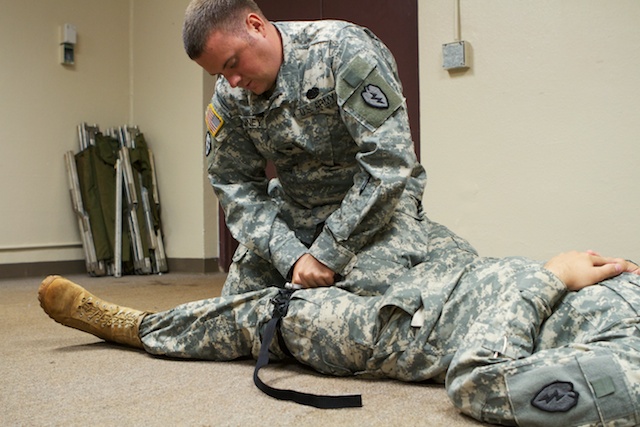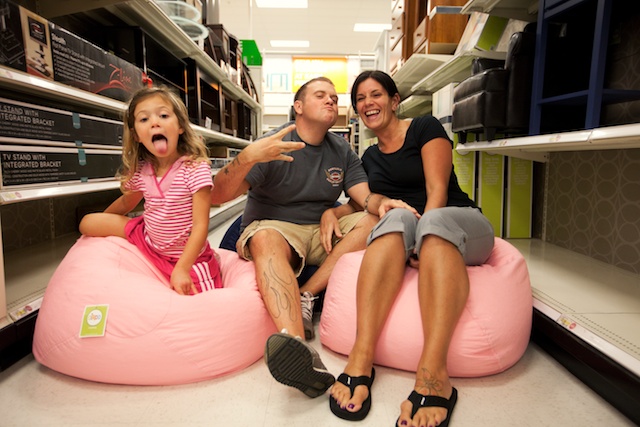
Schoffield Barracks, HI--Specialist Mathew "Doc" Kenney demonstrates to a group of medics how to apply a tourniquet. He is preparing for his next deployment, to Afghanistan. Credit: Jonathan Levinson
BY MIMI WELLS
Specialist Mathew “Doc” Kenney sat in the backseat of the third heavily armored MRAP, near the window. It was around midnight on Easter Sunday, 2009, and the four-car convoy was returning home from escorting a group of contractors to a neighboring base. The soldiers were nearing the halfway point in an uneventful deployment to Bayjii in northern Iraq and had seen very little fighting. Save for the rumbling of their massive vehicles on the transport road the countryside was still.
They were joking about Star Wars when Kenney, a medic on his first deployment, saw the light slash the sky. The boom that followed was so loud that for a moment, the soldiers in the third car thought they had been hit. Frantically they called out to each another. One by one they realized they were fine. But Kenney, 25, could see that the vehicle behind them—the “trail” truck—was smoking and splayed awkwardly across the road.
Kenney grabbed the radio. “Trail truck’s down! Trail truck’s down!” he screamed. His driver pulled the MRAP back around to the mangled vehicle. Kenney opened his door and stepped into the pitch-black darkness.
Except for treating their interpreter for heat stroke, this was his first emergency in Iraq.
“It’s what medics call that blind leap of faith,” he said ten months later, sitting in the living room of the home he shares with his wife and stepdaughter on the Schofield Barracks Army base in Hawaii. “You’re stepping out of that vehicle and going into the unknown where something has just exploded, and you’re going to be the first one going in.”
A quick scan of the truck revealed that the two back doors had been blown off, but the soldier seated in the rear was uninjured, and incredibly, had started pulling security duty. Sergeant Justin Minisall sat dazed in the passenger seat. His face was cut up, and Kenney thought his leg was broken, but Minisall was stable and responsive. Kenney moved towards the midsection of the vehicle where the gunner, Specialist Michael Anaya, was slumped over in his turret, unconscious. His leg was ripped open from his buttocks to the middle of his thigh.
Kenney jumped into the truck and yanked Anaya out of his restraints. Blood poured from his open leg and Kenny reached in to pinch the artery. He moved quickly, with mechanical precision. Anaya, was the platoon favorite—a friendly, fun-spirited twenty-three year old from Crestview, Florida.
By now the other men from his truck had jumped out and were shifting through the wreckage. Soldiers from the other trucks were organizing a security cordon.
The platoon leader screamed at Kenney to hurry up with Anaya and get to the driver’s seat, where Private Brendan “Rocco” Marrocco, 22, lay in a pool of exploded blood and bone.
“‘Rocco’s messed up pretty bad,” said the platoon leader. “You got to get to him.”
Kenney looked up from the middle of the vehicle, where he crouched over Anaya’s unconscious body. His uniform was covered in the gunner’s blood.
“I’ve got one at a time, man.”
He stabilized Anaya, and shouted for the team leader to come and stay with him. Then he jumped out of the truck and ran around to the driver’s side. He and another soldier pulled Marrocco out.
“It was just, he was just a stump,” said Kenney, pausing between the words. “I mean there was just his trunk and a head. He had one leg barely dangling on.”
For the next fifteen minutes Kenney worked “in robot mode;” running back and forth between the injured, without emotion. He was afraid that any expression would cause the rest of the soldiers to descend into panic.
“Is everyone OK? Is everything OK?” The men asked and Kenney lied. “Yeah, it’s fine. We’re good,” he said.
He was not sure Marrocco would make it; in 2009 no man had survived having both arms and legs ripped from his body in either Iraq or Afghanistan. Kenney’s training told him that Anaya had the best chance among the wounded, but as he worked to stop Marrocco’s blood from spilling out of his extremities he did not think of odds. He thought only of the medevac helicopters. The explosion had hit the convoy just eight miles from the front gate of their base. “Where the hell are the birds?” Kenney screamed to himself.
Doctors call the first 60 minutes after a traumatic injury the, “golden hour.” If emergency responders can get the victim to a well-equipped facility within an hour of the incident there is a high likelihood of survival. In Iraq in 2009, 95% of soldiers survived their injuries when they were rescued in the first hour, according to U.S. Central Command. For every moment outside of that window, the chances of survival plummet.
In 2009, the average medevac helicopter took 55 minutes to reach critically wounded soldiers.
Fifteen minutes turned into thirty. Forty. Then, fifty. An hour passed. Dilapidated power lines strung above the road popped and snapped. The soldiers were jumpy. Kenney moved through the darkness, kneeling down to inject morphine, check vital signs, and monitor for shock. His adrenaline turned to frustration, and then to anger.
Finally, 80 minutes after his radio call, two medevac helicopters arrived. Kenney spoke to the sergeant in charge of the evacuation team. “I was just like, this is what’s going on. Bam. Bam. Bam. I was probably talking 100 miles a minute,” he said.
Marrocco was loaded into one helicopter. Minisall, the sergeant with the broken leg, and Anaya were put in the other.
“We separated,” said Kenney, “and then everything started flooding in.”
Investigators studied the crater left by the blast. Someone traced the wires that had triggered the explosion into the field along the roadside. Kenney canvassed the area, looking for Marrocco’s body parts. He found a glove, with a perfectly formed hand inside and put it in his pocket. The other soldiers looked at him like he was crazy.
At 5:30 in the morning the men arrived back at their base. A crowd of soldiers who had been listening in on the radios all night stood waiting for them. Kenney was the last to get out of the truck. When the soldiers saw his uniform, soaked in blood, some began to cry.
There was no word of Marrocco’s or Anaya’s status. Kenney walked to the aide station. He handed Marrocco’s body parts to the staff sergeant. Then he took off his helmet threw it across the room.
“You take off your heavy gear and then you’re light, and then you’re pissed,” he said. His eyes filled with tears, and he wrung his hands together. “You’re pissed that that had to happen, that it had to happen to your guys.”
An hour later, the platoon sergeant gathered the 24 soldiers of Alpha Company together in the grey dawn outside the aide station. Minisall and Marrocco had survived. Michael Anaya was dead.
